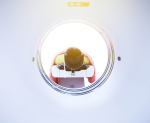CT dose: How much is just enough?
September 23, 2019
by John R. Fischer, Senior Reporter
Ten years ago, radiologists and medical imaging stakeholders received an alarming wake up call. A report issued by the National Council of Radiation Protection and Measurements (NCRP) revealed that the radiation exposure to the U.S. population from medical procedures had risen dramatically over the span of a few decades.
This concern around radiation dose marked a turning point for the medical imaging industry, paving the way for accreditation programs and official dose committees, as well as the maturation of dose technologies and, more broadly, a greater awareness of dose exposure. New initiatives pushed for more discretion when choosing diagnostic imaging exams and ensuring providers were adequately equipped to determine, deliver and monitor the exposure of their patients.
A prime example is the ACR Dose Index Registry (DIR), which many providers rely on to compare their CT dose data to their peers locally and nationally. Since 2011, the program has amassed nearly 2,200 facilities as active participants and contains data from more than 81 million CT scans.
“The information provided helps facilities to examine and review their CT protocols, and where necessary, cut down and optimize their techniques for improving their CT imaging,” Dr. Mahadevappa Mahesh, ACR Medical Physics Commission chair and chief physicist for Johns Hopkins Hospital, told HCB News. “Also, the ACR-DIR data are facilitating to set national or regional diagnostic reference levels for a variety of CT exams. Recently efforts are underway to roll out a dose index registry for fluoroscopy exams.”
But dose registries and improvements to technology don’t resolve radiation exposure issues unless providers act on them. That means taking up the mission of ensuring patients receive the right types of exams with just enough dose to obtain a reliable diagnostic image.
Dose vs. image quality
One way radiologists are getting quality images with lower dose exposure is through iterative reconstruction, a type of software algorithm that collects noisy data produced by low-dose scans and reconstructs it into an image with improved quality. The arrival of artificial intelligence, machine learning and especially deep learning, have all raised the bar on what’s possible with iterative reconstruction.
"Deep learning brings the right tool for using bigger data," said Dr. Ge Wang, a chair professor of biomedical engineering at Rensselaer Polytechnic Institute. "It can reconstruct high-quality CT images from very noisy data. Multiple papers have been published on the subject with excellent results. Low-dose CT reconstruction can be done now with a deep neural network. This is really a cutting-edge development with real-world utilities."
As a result, more CT manufacturers are integrating these tools into their scanners. Other dose management technologies long in use, such as dose modulation, which enables the scanner to adjust radiation dose based on factors such as the patient’s size and heartbeat, are also maturing due to new capabilities.
“The biggest challenge for imaging professionals is to be well-trained on the equipment and keeping up-to-date with technological advancements, to maximize patient safety and image quality,” said Vino Durairaj Ph.D., DABR, regional vice president of technical operations at West Physics. “That, I think, is where most imaging facilities are facing a challenge.”
The right dose for the right patient
Ten or twenty years ago, protocols for a head CT or a chest CT would be the same for all types of patients. Now, it is possible to tailor dose based on patient size. “Technologies such as dose modulation, along with awareness, are helping to customize dose on an individual level,” said Mahesh.
Specific factors to consider depend on the scan, with common ones including age, body size and weight. Cases involving pediatric patients especially should take these factors into consideration, according to Durairaj.
“If a pediatric patient has an adult-sized body part and you’re using pediatric imaging protocols you would normally use, then the image quality is going to be compromised,” he said. “In that case, we are not providing the patient care required for that particular patient.”
The ACR’s CT Accreditation program not only raises awareness about dose protocols, but ensures that sites implement them for lower and appropriate dose levels. Using the knowledge they gain from these programs, facilities are examining and adjusting their imaging protocols to meet industry standards, which has led to a downward trend in radiation dose. Also helping are campaigns such as Image Wisely and Image Gently, which provide information about dose and certification.
“A lot of participants take an Image Wisely pledge,” said Dr. Durairaj. “The participants display pledge certificates in the imaging department so when patients walk in, they feel welcomed and say, ‘Okay, the imaging professionals that are scanning me today are conscious in dose reduction strategies and dedicated to following patient safety initiatives.’”
Administering CT dose responsibly is a team effort that requires different stakeholders within the imaging process to have a voice. According to Gregg Daversa, vice president of business development for West Physics, one of the keys to establishing a culture of dose optimization is formalizing an official dose committee that meets on a regular basis.
“An ideal CT dose committee would involve a radiologist, a medical physicist, a lead CT technologist, and a business administrator,” he said. “When you get these four stakeholders at the table is when the core team comes together to take the data they’ve been working with and implement changes to optimize dose and image quality.”
New challenges and new hopes
Patients are becoming increasingly aware of the risks involved in radiation exposure, and misinformation is a fact of life for many people researching imaging exams online. This creates a unique challenge for providers, who are tasked with articulating relative pros and cons, as well as sharing facility details concerning accredited and quality control programs.
“At the radiation dose levels used for routine medical imaging such as CT, there is no good evidence to demonstrate adverse effects,” said Mahesh. “However, there is confusion about this and depending on who spins the story, people are often really concerned even with routine medical imaging.”
Mahesh is currently involved in a follow-up to the 2009 NCRP report which is called Medical Radiation Exposure of Patients in the United States, and is expected to be released in November. The report should give an indication as to whether or not efforts to reduce dose have had a substantial impact in the last 10 years.
“From my experience, most imaging facilities attempt to meet the compliance of regulatory and accreditation bodies implementing the standards, whereas others strive to reach a balance between dose and image quality,” said Durairaj. “There is certainly a gap between facilities that try to achieve compliance versus those that go above and beyond all optimization fronts put forth by the regulatory and accreditation bodies.”
At the same time, vendors are also helping to ensure patients receive optimized doses by taking into account protocols, regulations and needs around CT dose in the technologies they develop. As iterative reconstruction and machine learning techniques continue to complement each other, some experts are hopeful that a new era of patient safety and dose optimization could be on the horizon.
"There are so many new, exciting, out-of-the-box technologies coming out in areas such as natural language programming, neural networks and quantum computing," said Wang. "They all may turn out to be very important, so it's very hard at this point to predict the future."
This concern around radiation dose marked a turning point for the medical imaging industry, paving the way for accreditation programs and official dose committees, as well as the maturation of dose technologies and, more broadly, a greater awareness of dose exposure. New initiatives pushed for more discretion when choosing diagnostic imaging exams and ensuring providers were adequately equipped to determine, deliver and monitor the exposure of their patients.
A prime example is the ACR Dose Index Registry (DIR), which many providers rely on to compare their CT dose data to their peers locally and nationally. Since 2011, the program has amassed nearly 2,200 facilities as active participants and contains data from more than 81 million CT scans.
“The information provided helps facilities to examine and review their CT protocols, and where necessary, cut down and optimize their techniques for improving their CT imaging,” Dr. Mahadevappa Mahesh, ACR Medical Physics Commission chair and chief physicist for Johns Hopkins Hospital, told HCB News. “Also, the ACR-DIR data are facilitating to set national or regional diagnostic reference levels for a variety of CT exams. Recently efforts are underway to roll out a dose index registry for fluoroscopy exams.”
But dose registries and improvements to technology don’t resolve radiation exposure issues unless providers act on them. That means taking up the mission of ensuring patients receive the right types of exams with just enough dose to obtain a reliable diagnostic image.
Dose vs. image quality
One way radiologists are getting quality images with lower dose exposure is through iterative reconstruction, a type of software algorithm that collects noisy data produced by low-dose scans and reconstructs it into an image with improved quality. The arrival of artificial intelligence, machine learning and especially deep learning, have all raised the bar on what’s possible with iterative reconstruction.
"Deep learning brings the right tool for using bigger data," said Dr. Ge Wang, a chair professor of biomedical engineering at Rensselaer Polytechnic Institute. "It can reconstruct high-quality CT images from very noisy data. Multiple papers have been published on the subject with excellent results. Low-dose CT reconstruction can be done now with a deep neural network. This is really a cutting-edge development with real-world utilities."
As a result, more CT manufacturers are integrating these tools into their scanners. Other dose management technologies long in use, such as dose modulation, which enables the scanner to adjust radiation dose based on factors such as the patient’s size and heartbeat, are also maturing due to new capabilities.
“The biggest challenge for imaging professionals is to be well-trained on the equipment and keeping up-to-date with technological advancements, to maximize patient safety and image quality,” said Vino Durairaj Ph.D., DABR, regional vice president of technical operations at West Physics. “That, I think, is where most imaging facilities are facing a challenge.”
The right dose for the right patient
Ten or twenty years ago, protocols for a head CT or a chest CT would be the same for all types of patients. Now, it is possible to tailor dose based on patient size. “Technologies such as dose modulation, along with awareness, are helping to customize dose on an individual level,” said Mahesh.
Specific factors to consider depend on the scan, with common ones including age, body size and weight. Cases involving pediatric patients especially should take these factors into consideration, according to Durairaj.
“If a pediatric patient has an adult-sized body part and you’re using pediatric imaging protocols you would normally use, then the image quality is going to be compromised,” he said. “In that case, we are not providing the patient care required for that particular patient.”
The ACR’s CT Accreditation program not only raises awareness about dose protocols, but ensures that sites implement them for lower and appropriate dose levels. Using the knowledge they gain from these programs, facilities are examining and adjusting their imaging protocols to meet industry standards, which has led to a downward trend in radiation dose. Also helping are campaigns such as Image Wisely and Image Gently, which provide information about dose and certification.
“A lot of participants take an Image Wisely pledge,” said Dr. Durairaj. “The participants display pledge certificates in the imaging department so when patients walk in, they feel welcomed and say, ‘Okay, the imaging professionals that are scanning me today are conscious in dose reduction strategies and dedicated to following patient safety initiatives.’”
Administering CT dose responsibly is a team effort that requires different stakeholders within the imaging process to have a voice. According to Gregg Daversa, vice president of business development for West Physics, one of the keys to establishing a culture of dose optimization is formalizing an official dose committee that meets on a regular basis.
“An ideal CT dose committee would involve a radiologist, a medical physicist, a lead CT technologist, and a business administrator,” he said. “When you get these four stakeholders at the table is when the core team comes together to take the data they’ve been working with and implement changes to optimize dose and image quality.”
New challenges and new hopes
Patients are becoming increasingly aware of the risks involved in radiation exposure, and misinformation is a fact of life for many people researching imaging exams online. This creates a unique challenge for providers, who are tasked with articulating relative pros and cons, as well as sharing facility details concerning accredited and quality control programs.
“At the radiation dose levels used for routine medical imaging such as CT, there is no good evidence to demonstrate adverse effects,” said Mahesh. “However, there is confusion about this and depending on who spins the story, people are often really concerned even with routine medical imaging.”
Mahesh is currently involved in a follow-up to the 2009 NCRP report which is called Medical Radiation Exposure of Patients in the United States, and is expected to be released in November. The report should give an indication as to whether or not efforts to reduce dose have had a substantial impact in the last 10 years.
“From my experience, most imaging facilities attempt to meet the compliance of regulatory and accreditation bodies implementing the standards, whereas others strive to reach a balance between dose and image quality,” said Durairaj. “There is certainly a gap between facilities that try to achieve compliance versus those that go above and beyond all optimization fronts put forth by the regulatory and accreditation bodies.”
At the same time, vendors are also helping to ensure patients receive optimized doses by taking into account protocols, regulations and needs around CT dose in the technologies they develop. As iterative reconstruction and machine learning techniques continue to complement each other, some experts are hopeful that a new era of patient safety and dose optimization could be on the horizon.
"There are so many new, exciting, out-of-the-box technologies coming out in areas such as natural language programming, neural networks and quantum computing," said Wang. "They all may turn out to be very important, so it's very hard at this point to predict the future."




